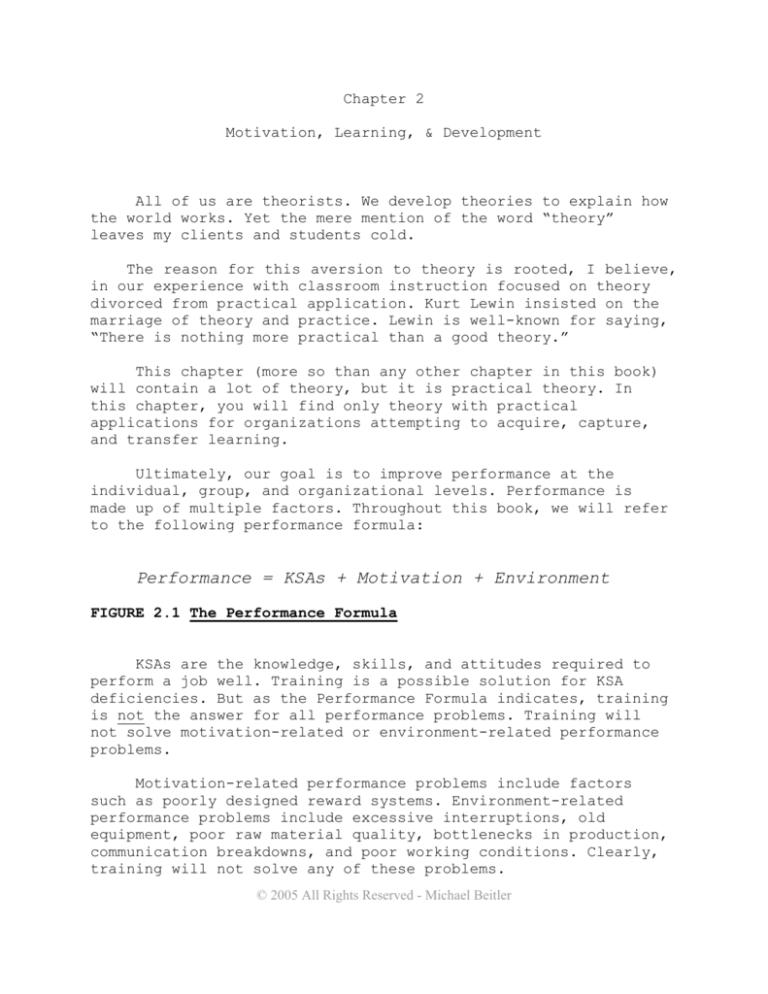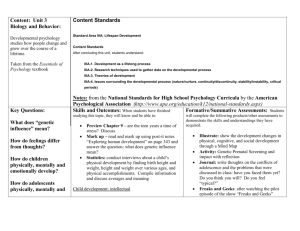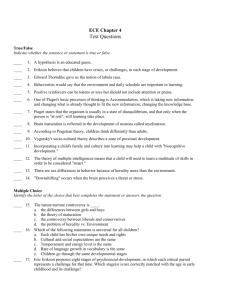
Chapter 2
Motivation, Learning, & Development
All of us are theorists. We develop theories to explain how
the world works. Yet the mere mention of the word “theory”
leaves my clients and students cold.
The reason for this aversion to theory is rooted, I believe,
in our experience with classroom instruction focused on theory
divorced from practical application. Kurt Lewin insisted on the
marriage of theory and practice. Lewin is well-known for saying,
“There is nothing more practical than a good theory.”
This chapter (more so than any other chapter in this book)
will contain a lot of theory, but it is practical theory. In
this chapter, you will find only theory with practical
applications for organizations attempting to acquire, capture,
and transfer learning.
Ultimately, our goal is to improve performance at the
individual, group, and organizational levels. Performance is
made up of multiple factors. Throughout this book, we will refer
to the following performance formula:
Performance = KSAs + Motivation + Environment
FIGURE 2.1 The Performance Formula
KSAs are the knowledge, skills, and attitudes required to
perform a job well. Training is a possible solution for KSA
deficiencies. But as the Performance Formula indicates, training
is not the answer for all performance problems. Training will
not solve motivation-related or environment-related performance
problems.
Motivation-related performance problems include factors
such as poorly designed reward systems. Environment-related
performance problems include excessive interruptions, old
equipment, poor raw material quality, bottlenecks in production,
communication breakdowns, and poor working conditions. Clearly,
training will not solve any of these problems.
© 2005 All Rights Reserved - Michael Beitler
Chapter 2
Motivation, Learning, & Development
When diagnosing performance problems, it is important to
make a distinction between training (KSA) needs and non-training
(motivational or environmental) needs. A needs analysis should
reveal deficiencies in KSAs, motivational factors, and/or
environmental factors. Any motivational or environmental needs
revealed in the needs analysis should be discussed with the
managers who have the authority (and motivation) to make the
necessary changes. We will look at how to do a needs analysis in
the next chapter.
Motivational Theories
For many of you, this section will be a basic review of the
motivational theories you learned in a “Principles of
Psychology” or an “Organizational Behavior” course. It is
essential that you are familiar with these theories as they
provide a basis (along with adult learning theory, which we’ll
discuss next), for effective use of the strategies and
techniques covered later in this book.
Maslow & Alderfer
Let’s begin with Maslow’s (1954) Hierarchy of Needs model. Many
academics refuse to accept this as a scientific model, but
practitioners (managers and consultants) use it every day. The
model is simple, but the implications for practice are powerful.
Maslow believed there were five levels of needs; the lower
level needs must be satisfied before the higher level needs
become motivating. Maslow envisioned needs in the following
hierarchy:
2
© 2005 All Rights Reserved - Michael Beitler
Chapter 2
Motivation, Learning, & Development
FIGURE 2.2 Maslow’s Hierarchy of Needs
Practically speaking, most of the organizational members we
are working with are not focused on their physiological and
safety needs; they are focused on higher-level needs. Since few
people are operating at the self-actualization (SA) level, most
people we’ll encounter are focused on their social and esteem
needs. To motivate these individuals, we must show them how
their efforts will fulfill their social and esteem needs.
Alderfer’s (1969) ERG theory builds upon Maslow’s theory.
Alderfer’s existence needs correspond with Maslow’s
physiological and safety needs. Alderfer’s relatedness needs
correspond to Maslow’s social needs. And Alderfer’s growth needs
correspond to Maslow’s esteem and self-actualization needs.
Keep in mind, it is our unsatisfied needs that motivate us.
Satisfied needs are no longer motivating. Appealing to
somebody’s satisfied needs will not lead to motivation.
Alderfer’s theory recognizes more complexity in the
motivation process than did Maslow’s. Alderfer spoke of needs
that expand overtime, such as a desire for better food or a
bigger house.
Behavioral Theory & Motivation
3
© 2005 All Rights Reserved - Michael Beitler
Chapter 2
Motivation, Learning, & Development
In a spirit of full disclosure, I must admit I don’t like
behavioralism or the behaviorists (e.g., Watson and Skinner). I
believe behavioralism dehumanizes people by ignoring their
wonderful cognitive abilities. In graduate school, I had the
opportunity to take a course with Albert Ellis, the leading
cognitive psychologist, so I confess to being an advocate of
cognitive psychology.
However, in a spirit of fairness, I must admit that the
behaviorists have made some valuable contributions to our
understanding of motivation. John Watson said, “Whatever
behavior you reward, you get more of.” The implication for all
of us (not just trainers and managers) is clear; we must design
and maintain reward systems that encourage desired behaviors. A
poorly designed, or maintained, reward system that rewards the
wrong behaviors can render an otherwise well-designed training
or learning program ineffective.
The behaviorists spoke of positive reinforcement, negative
reinforcement, and punishment. Understanding these three
concepts is essential in designing a reward system.
Positive reinforcement involves the receipt of something
desirable after a behavior. Negative reinforcement is the
removal of something undesirable (a double negative). Both
positive reinforcement and negative reinforcement are positive
events. Both are valuable in management and training because
both encourage (motivate) positive future behaviors.
Punishment should not be confused with negative
reinforcement. Punishment does not encourage positive future
behavior; its purpose is to eliminate negative future behaviors.
While punishment is sometimes appropriate (e.g., firing an
employee for theft or poor customer service), it must be used
sparingly.
The inappropriate use of punishment can lead to several
problems:
1. It does not motivate people to do the right thing. Instead,
people become focused on not doing the wrong thing; it can
4
© 2005 All Rights Reserved - Michael Beitler
Chapter 2
Motivation, Learning, & Development
lead to doing nothing, in order to remain “safe.”
2. It establishes somebody (e.g., manager or trainer) as the
“punisher.” Punishers are not well liked; punishers are
feared. Punishers are not in a position to build positive
working relationships. Nobody wants to build a relationship
with the punisher.
3. It requires constant monitoring. If the wrong behavior still
offers some kind of reward, some individuals will continue
the wrong behavior when the punisher is out of sight.
Cognitive Theory & Motivation
Cognitive psychologists, including Albert Ellis, reject the S-R
(stimulus-response) model of the behavioral psychologists as too
simplistic (Ellis & Dryden, 1987). Ellis offers the following AB-C model to help us understand the role of perception:
A
B
C
Activating Event
Belief about the Activating Event
Consequential Behavior or Thinking
The “A” (activating event) in Ellis’s model corresponds to
the “S” (stimulus) in the behavioral model. The “C”
(consequential behavior or thinking) corresponds to the “R”
(response) in the S-R model.
Ellis suggests that the “B” (belief about the activating
event) is what causes the subsequent behavior (or thinking). The
“B” is the result of our cognitive processes. These cognitive
processes are what separate us from animals.
As managers, trainers, or consultants we must understand
somebody’s belief about an activating event (the “B”), if we
hope to understand his or her behavior. These beliefs
(perceptions) are a combination of expectations, values, and
assumptions. Only through skillful questioning can we understand
what is motivating somebody else’s behavior or thinking.
5
© 2005 All Rights Reserved - Michael Beitler
Chapter 2
Motivation, Learning, & Development
Beitler’s Motivation Model
My own motivation model is based on Victor Vroom’s (1964)
Expectancy Theory. Vroom’s model is widely accepted in the
academic world because of its complexity. Unfortunately, it is
ignored by practitioners for the same reason.
My own model of motivation (considerably simpler than
Vroom’s) is meant to be used as a tool in practice. My model
takes the form of a simple mathematical equation:
Level
of
=
Motivation
Expectation
of
Success
Trust in
Receiving
the Reward
X
X
Perceived
Value of
the Reward
FIGURE 2.3 Beitler’s Motivation Model
Whenever someone (manager or trainer) tries to motivate
someone else (subordinate or trainee), all three factors must be
considered. Let’s use the example of a manager trying to
motivate a subordinate. The manager says, “If you successfully
complete this task you will be rewarded with _____.”
Immediately, the subordinate considers his or her
expectation of success. If the expectation of successfully
completing the task is low, motivation will be low.
If the subordinate’s trust in receiving the reward is low,
motivation is low. Perhaps other employees have been promised a
promotion or bonus for completing the same task, but they did
not receive a promotion or bonus.
Finally, the subordinate will consider his or her perceived
value of the reward. Once again, if the perceived value of the
reward is low, motivation will be low.
6
© 2005 All Rights Reserved - Michael Beitler
Chapter 2
Motivation, Learning, & Development
As you know, whenever you are doing multiplication, if any
of the factors are zero, the result is zero. The implications
are significant.
If the subordinate believes that the possibility of
successfully completing the task is zero, no amount of money (or
perceived value of a reward) will motivate him or her. If the
subordinate’s trust in receiving the promised reward is zero, no
amount of money (or perceived value of a reward) will motivate
him or her.
Finally, if the value of the reward is perceived as zero,
motivation is zero unless the subordinate is motivated by
something other than the promised reward. Please note, what
matters here is the subordinate’s perception, not the manager’s.
This model of motivation suggests how critically important
the open and honest communication of expectations and values is
to organizational effectiveness.
Self-Confidence & Motivation
What is often mistakenly called
self-confidence problem. Albert
contributions to the concept of
defined as one’s feelings about
a motivational problem can be a
Bandura has made some valuable
self-efficacy. Self-efficacy is
one’s own competency.
Bandura (1977a) stated that individuals with low selfefficacy are preoccupied with concerns about failure. Ford,
Smith, Weissbein, Gully, and Salas (1998) added to Bandura’s
insights with their research. They found, in various situations,
that individuals with high self-efficacy try harder; those with
low self-efficacy often reduce their effort or give up.
Blanchard and Thacker (2004) added a valuable insight by
saying, “If failure is expected, the employee acts to minimize
the negative consequences of failure. For example, withdrawing
from the activity (refusing to try) moves the person away from
proven failure to simply ‘I didn’t try!’” (p.84).
7
© 2005 All Rights Reserved - Michael Beitler
Chapter 2
Motivation, Learning, & Development
Building self-confidence is often a necessary “prelearning” activity. A lack of self-confidence should be revealed
during a needs analysis.
Adult Learning Theories
Everybody claims to have experienced learning, yet nobody
seems able to clearly define what learning is. We know that
learning occurs physically. “Learning is related to changes in
the physical, neuronal structure of the brain and its related
electrochemical functioning” (Blanchard & Thacker, 2004, p.85).
Unfortunately, debating definitions of learning and discussing
brain activity during learning are beyond the scope of this book.
For our purposes, we need to be aware of the two opposing
approaches to learning theory and the implications of those
approaches for adult and organizational learning. The two
different approaches, behavioral and cognitive, have the same
roots as those discussed in the previous section on motivation.
Behaviorists vs. Cognitivists
Behaviorists define learning as a relatively permanent change in
behavior. The behaviorists de-emphasize the brain or mental
activity in the learning process. B.F. Skinner (1971), the most
ardent of behaviorists, believed the brain is simply like any
other organ; its neural activities are conditioned to occur
based upon a past history of consequences. “Learning occurs when
new consequences are experienced” (Blanchard & Thacker, 2004,
p.86).
Cognitivists define learning as a change in cognition.
Cognition refers to the mental processing of information.
Cognitivists believe, “Even though learning can be inferred from
behavior, it is separate from the behavior itself” (Blanchard &
Thacker, 2004, p.85). As in the previous section on motivation,
I agree with the cognitive theorists.
8
© 2005 All Rights Reserved - Michael Beitler
Chapter 2
Motivation, Learning, & Development
Implications of the Two Approaches
As you can imagine, there are significant differences in
practice when training or learning is designed and conducted by
a behaviorist, as opposed to a cognitivist. Let’s look at a few
of the implications:
Instructional Goals
Learner’s Role
Trainer’s Role
Control
Behavioral
Trainer
Developed
Cognitive
Collaboratively
Developed
Passive
Director
Trainer
Active
Facilitator
Learner
FIGURE 2.4 Practice Implications of the Two Approaches
The implications are quite dramatic. “In the behaviorist
approach, the trainer controls learning by controlling the
stimuli and consequences that the learner experiences”
(Blanchard & Thacker, 2004, p.86). In the cognitive approach, it
is assumed learners have their own goals, priorities, and
learning style preferences.
The behaviorist approach has obvious applications for
childhood education, but I question its use in adult education
and training.
Assimilation & Accommodation
Piaget is best known for his work on child development, but his
insights are also valuable for adult and organizational learning.
Piaget (1954) spoke of “assimilation” and “accommodation”
in terms of cognitive maps. Cognitive maps are made up of
categories created to help us understand the world.
9
© 2005 All Rights Reserved - Michael Beitler
Chapter 2
Motivation, Learning, & Development
When we experience something for which we have an existing
category we can assimilate it into that category. When we
experience something for which we do not have an existing
category we must accommodate for it by creating a new category.
During my college days, I took a calculus course. The
instructor, a brilliant engineer, assumed we could assimilate
the new information (calculus) into our cognitive maps of the
world. Unfortunately, while he could assimilate calculus into
his existing categories containing engineering tools, none of us
in the class had such categories. What we needed was help in
creating a new category to accommodate for this new knowledge.
We must remember that people need ways to organize their
experiences (and knowledge) to enable them to understand the
world around them. We can help facilitate the assimilation and
accommodation processes.
Social Learning Theory
Bandura’s (1977b) “Social Learning Theory” proposes that
individuals can learn by observing others and the consequences
of other people’s behavior. Since this learning comes through
observing others, Bandura’s theory is also called observational
or vicarious learning. But there is more to Bandura’s theory
than the learning power of observation.
Bandura also stressed the importance of “attention” and
“retention.” He believed the learning process does not begin
until the learner’s attention is focused. There are serious
implications here for trainers. Objectives and benefits for the
learner must be discussed first to obtain learner attention. Put
simply, no attention, no learning.
Adults do not retain all the information they see or hear.
Bandura believes trainers can facilitate the cognitive process
of retention. There are many ways available. Noe (2005) states,
“Behaviors or skills can be coded as visual images (symbols) or
verbal statements” (p.110). Blanchard and Thacker (2004) add,
“This process, cognitive organization, can be facilitated in
10
© 2005 All Rights Reserved - Michael Beitler
Chapter 2
Motivation, Learning, & Development
training by asking the trainees to provide examples of how the
new information relates to what they already know” (p.99).
Pedagogy vs. Andragogy
Malcolm Knowles (1990) made a major contribution to our
understanding of adult learners by giving us the concept of
“andragogy.” Until Knowles, pedagogy, the study of teaching
children, dominated learning theory. “Pedagogy gives the
instructor major responsibility for making decisions about
learning content, method, and evaluation” (Noe, 2005, p.114).
Pedagogy clearly applies to teaching children; it is generally
ineffective when teaching adults.
Knowles’ theory of andragogy makes the following five
assumptions about adult learners:
1.
2.
3.
4.
5.
they
they
they
they
they
need to know why they are learning something
need to be self-directed
bring work-related experiences with them
have a problem-solving approach to learning
are motivated by both extrinsic and intrinsic rewards
Clearly, adult learners are seeking a facilitator for their
learning projects, not an all-knowing guru. Adult learners want
to retain as much control as possible over the learning process.
Knowles’s theory of andragogy leads us into a necessary,
albeit brief, discussion of adult development theories.
Adult Development Theories
Understanding adult development theories sheds much light
onto adult learning needs. The theories of adult development can
be classified into three basic categories:
11
© 2005 All Rights Reserved - Michael Beitler
Chapter 2
Motivation, Learning, & Development
1) trait models – in which patterns of individual behavior are
seen as being constant over time (exemplified by Allport’s
theory),
2) stage models – in which development is seen as predictable
changes over time (exemplified by the theories of Erikson and
Levinson),
3) interactional models – in which development is seen as the
result of the interaction among age-related, cohort/history
related, and non-normative life events (exemplified by the
work of Neugarten and Schlossberg).
Trait Models
Supporters of the trait (or stability) models of adult
development use trait theory to support their beliefs. Trait
theorists believe traits (e.g., friendliness or aggression)
account for the consistency in human behavior. The leading trait
theorist, Gordon Allport (1897-1967), suggested, “If a person’s
traits are known, it is possible to predict how he or she will
respond to various environmental stimuli” (1937, p.28). In other
words, “traits will guide their behavior, because people can
respond to the world only in terms of their traits” (Hergenhahn,
1990, p.182).
Allport believed people react differently to the same
stimulus because different traits are involved. While Allport
believed each individual was unique because of his or her unique
combinations of traits, he believed that traits were basically
fixed. Allport is well-known for his following statement about
the fixed nature of human traits: “The same fire that melts the
butter hardens the egg” (1961, p.72). The influence of
environmental factors is determined by one’s nature.
Stage Models
Numerous theorists (Piaget, Freud, Erikson, and Levinson) have
argued for stage (or predictable change) models of development.
12
© 2005 All Rights Reserved - Michael Beitler
Chapter 2
Motivation, Learning, & Development
Erik Erikson (1902-1990) was once a follower of Freud. An
important contribution of his theory is the epigenetic principle.
According to Erikson (1980), the concept of epigenesis has its
roots in the biological principle that development of an embryo
proceeds according to a predetermined plan. With this plan, each
organ has its own time of maximum growth and development. If the
parts develop properly, they will eventually form an integrated,
functional whole. In psychosocial terms, Erikson translated the
epigenetic principle to say that the demands of one stage lay
the groundwork for the resolution of future tasks.
Erikson is best known in developmental psychology for his
model of eight stages of development. His sixth and seventh
stages, concerning young and middle adulthood, provide a
foundation for the current stage models of adult development.
In 1978, Daniel Levinson, a social psychologist at Yale
University, published his book entitled Seasons of a Man’s Life.
The book greatly expanded Erikson’s seventh stage of adult
development (generativity vs. stagnation), but emphasized the
crisis nature of the midlife stage.
Levinson (1978) sees human development not as a continuous
process, but as alternating stages of stability and change. This
concept of alternating periods of stability and instability is
clearly Piagetian. Levinson’s concept of the life cycle suggests
an underlying pattern to human growth similar to Erikson’s
epigenetic principle. Levinson believes that individuals proceed
in an age-related series of emotional and physical transitions.
Some stage theorists (Gould, 1978; Levinson, 1978) believe
the midlife transition is the great transition. The focus of
this stage is on the loss of youth and faltering physical powers
that had been taken for granted. Additionally, there is a
yearning for “individualness” and “undividedness.” No matter
what a person is doing or has done, parts of him/herself have
been suppressed. The major task of this stage is the
reintegration of the ignored parts.
13
© 2005 All Rights Reserved - Michael Beitler
Chapter 2
Motivation, Learning, & Development
The stage theorists assure us that a period of stability
will follow the turbulent midlife transition. Like Freud’s stage
theory, they see adults moving into and out of midlife
transition like clockwork--unfinished business or not. In other
words, midlife transition is just a stage (like the “terribletwo’s”); adults grow out of it.
Interactional Models
Advocates of the interactional (or flexible-contextual) models,
argue that the first two types of models are too simplistic.
While most two-year-olds are at a similar developmental level
(and exhibit similar behaviors), a forty-year-old professional
athlete has little in common with a forty-year-old heart surgeon.
Historically, Carl Jung was one of the first writers to
offer a model of midlife development that was not based on
assumptions of predictability. While Jung believed fundamental
changes in adult development occurred at about age forty, he
“understood individual adult development as a product of both
psychological processes and cultural forces” (Miesel, 1991,
p.52).
Bernice Neugarten and other researchers at the University
of Chicago “point out that their studies show that chronological
age is an increasingly unreliable indicator of what people will
be like at various points in their development” (Miesel, 1991,
p.60). Neugarten went on to say, “The scenarios and schedules of
our lives are so varied that it is virtually impossible to talk
about a single timetable for adult development” (Miesel, 1991,
p.60).
Nancy Schlossberg (1987) says her research indicates that
chronological age is one of the least important factors in the
differences between how people experience transitions.
Schlossberg says, “because the adult years are so variable, we
cannot assume that particular transitions will necessarily occur
at specific ages” (p.75). She believes what determines the
positive or negative effects of the transition are how the
14
© 2005 All Rights Reserved - Michael Beitler
Chapter 2
Motivation, Learning, & Development
individual views the transition, and his or her resources for
dealing with it.
The supporters of interactional models argue that what was
true for Levinson’s (1978) group (a particular cohort) will not
necessarily be true for another cohort born into a time with
different economic and social challenges. Interactional models
are built upon the interactionist belief that the individual
affects, and is affected by, his or her environment.
Summary
An understanding of the motivation, learning, and development
theories covered in this chapter is critical to successfully
applying the strategies and techniques discussed in this book.
For a deeper understanding of any of these theories, read some
of the referenced materials at the end of this chapter.
Now let’s shift our focus from theory to practice.
References
Alderfer, C. (1969). An empirical test of a new theory of
human needs. Organizational Behavior and Human
Performance, 4(2), 142-75.
Allport, G.W. (1937). Personality: A psychological
interpretation. New York: Holt, Rinehart, & Winston.
Allport, G.W. (1961). Patterns and growth in personality.
New York: Holt, Rinehart, & Winston.
Bandura, A. (1977a). Self-efficacy: Toward a unifying
theory of behavioral change. Psychological Review, 84:
191-215.
Bandura, A. (1977b). Social learning theory. Upper Saddle
River, NJ: Prentice Hall.
15
© 2005 All Rights Reserved - Michael Beitler
Chapter 2
Motivation, Learning, & Development
Blanchard, P.N. & Thacker, J.W. (2004). Effective training:
Systems, strategies, and practices (2nd ed.). Upper
Saddle River, NJ: Pearson/Prentice Hall.
Ellis, A. & Dryden, W. (1987). The practice of rationalemotive therapy. New York: Springer Publishing.
Erikson, E. (1980). Identity and the life cycle. New York:
Norton.
Ford, J., Smith, E., Weissbein, D., Gully, S., & Salas, E.
(1998). Relationships of goal orientation,
metacognitive activity, and practice strategies with
learning outcomes and transfer. Journal of Applied
Psychology, 83: 218-33.
Gould, R. (1978). Transformations: Growth and change in
adult life. New York: Simon & Schuster.
Hergenhahn, B.R. (1990). Theories of personality (3rd ed.).
Englewood Cliffs, NJ: Prentice Hall.
Knowles, M.S. (1990). The adult learner (4th ed.). Houston:
Gulf Publishing.
Levinson, D. (1978). The seasons of a man’s life. New York:
Alfred A. Knopf.
Maslow, A.H. (1954). Motivation and personality. New York:
Harper & Row.
Miesel, J.A. (1991). A phenomenological exploration of the
experience of voluntarily changing one’s career during
midlife. Unpublished doctoral dissertation. The Union
Institute, Cincinnati, OH.
Noe, R.A. (2005). Employee training and development (3rd
ed.). New York: McGraw-Hill Irwin.
Piaget, J. (1954). The construction of reality in the child.
16
© 2005 All Rights Reserved - Michael Beitler
Chapter 2
Motivation, Learning, & Development
New York: Basic Books.
Schlossberg, N. (1987). Taking the mystery out of age.
Psychology Today, 21(5), pp.74-85.
Skinner, B.F. (1971). Beyond freedom and dignity. New York:
Bantam/Vintage.
Vroom, V. (1964). Work and motivation. New York: Wiley.
17
© 2005 All Rights Reserved - Michael Beitler






